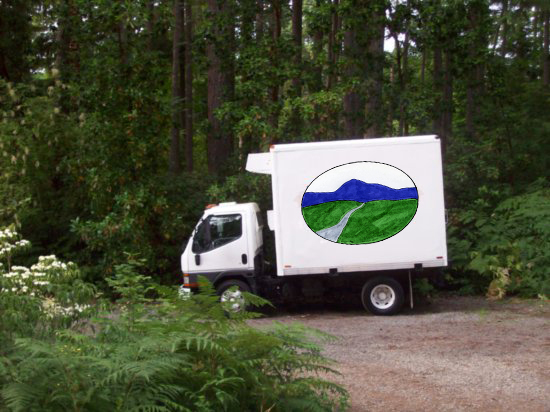As I drive around the city, headed to farmers markets, I’ve been thinking a lot about the sudden explosion of restaurants offering ‘local’ food, raised on ‘family farms’. It seems like everywhere I go, I see menus testifying that their food is locally raised. Sometimes, but less frequently, the name of the actual farm is listed on the menu, and the location. As a farmer who has been selling food in the D.C. metro area for over fifteen years, these claims aren’t cause for doubt or suspicion, and most certainly not envy. Very simply, the shear number of restaurants making this claim has me wondering: how, exactly, is all this food getting into town?
Let’s break this down into basic components. To begin, the underlying premise is that, somewhere locally, this food is being grown. As a farmer, I have no problem with this assertion. At this point on my career, I have a core network of agricultural peers to corroborate the notion that food can be grown abundantly and, in certain cases, year round, here in the mild climes of the Mid-Atlantic. I’ll be the first to attest, it’s a wonderful place to grow food. If farmers have the energy, creativity and -god bless them- the temerity to produce food every day of the year, it can certainly be done in some capacity in our local foodshed.
So, the ‘local’ aspect doesn’t concern me at all. We farmers are really good at growing food. We have to be: if we don’t, we lose our jobs! That being said, as our farm, Smith Meadows, initially shifted from being just a production farm to being both a production and a direct marketing farm, our biggest challenge had nothing to do with energy, creativity or -god bless us- temerity. We had all of these things in pitchforkfulls. No, what held us back for years and years was appropriately capitalized infrastructure.
This wonderful local food that’s available at your favorite restaurant… how exactly did it get there? And more importantly, what was the back story that allowed it to get there? As someone who has delivered food to restaurants for years, a bunch of basic questions rush through my mind. When was it picked? When was it loaded? Out of what intermediary holding facility? Onto what truck? Driven by whom? Delivered at what time? Did the delivery take time away from production? And how was any of this economically feasible?
It’s easy to romanticize an image of a farmer waking up in the wee hours, faithfully loading a truck filled with freshly picked produce, and merrily driving it into town before the sun has peeped over the mountain. By the time the delivery is done, the farmer has made it back to his farm just in time to milk the cows, feed the chickens, plant the corn, and pick another fresh load of food to be delivered the following day. Let’s go ahead and get really fictional, and imagine all this happening before noon.
While we’re at it, let’s go ahead and imagine that there’s no traffic, or construction delays on the Capital Beltway, or gridlock on Pennsylvania and 9th. We’ll avoid imagining a ticket on the farmers truck as he has to double park on M Street in downtown Georgetown, and we certainly won’t fabricate an irate chef, wondering why the farmer couldn’t find a place to park his large box truck in Adams Morgan.
In our corporately programmed minds, the answers are all so simple.
“Easy,” the young me would have said. “The farmer should just hire a driver.”
“Of course,” the experienced me replies. “He hires a driver… with what money?”
“From the money he gets from the restaurant, naturally.”
“Right,” the contemporary me counters. “After he negotiates the wholesale price that restaurants require, I’m sure there will be plenty of margin left over to pay a qualified, dependable driver. And after the farmer gets that check from the restaurant (thirty or sixty or… honestly, perhaps never), he can pay off his gasoline bill, and the auto insurance. By the way…” I ask. “Where did that truck come from, anyway?”
“Duh.” The old me replies without hesitation. “The farmer bought it.”
“How? Big, reliable, refrigerated trucks aren’t usually for sale on the average street corner.”
“He took out a loan, I guess.”
“Gotcha. So now, on top of paying the driver, and of course the gas (those trucks get about 8 to 10 mpg, don’t ask me how I know), the farmer also has to account for a truck payment. And all out of these bills will be covered by a wholesale (versus retail) check that may or may not ever be coming in the mail.”
“Well… I guess it must work for somebody, or no one would do it.”
I’ll end the conversation there for the moment, and reveal this. Those truck payments, the checks that never (ever) arrived, the double parking tickets? Those are all things I’ve personally experienced.
I’ve humped fifty pound coolers of food for blocks at 6 a.m. on a Sunday morning, only to find that the restaurant wasn’t even open, like the chef had promised. Standing outside a locked door, my calls go unanswered; five hours later, I’m told just to bring it by later that afternoon, at a more convenient time. I’ve had entire days of farming production lost as I sat in gridlock on the Dulles Toll Road, trying to get our food downtown to an anxiously waiting restaurant. I’ve worked myself to exhaustion doing the farm chores, ensuring that the daily agricultural production will be there, then later that evening loaded hundreds of pounds of food onto my truck and drove it into the city.
These stories aren’t complaints… they’re just personal experiences. After five years of this routine, I was effectively burned out. We now service two restaurants in the D.C. area, intentionally reduced from a peak of seven. When we deliver now, we make sure our restaurants are directly on our delivery route between farmers markets and the farm. It’s the only way we can sustainably make it work.
For a local farmer, it’s a double squeeze. How can anyone be producing food if they are always on the road? How can anyone make a profit when the start up infrastructure costs (truck, refrigerated food storage, fuel, electricity, paying a driver) are effectively cost prohibitive to a small farm? The ‘big boys’ operate with scale, and finance with debt. How sustainable is that model for the average local farm?
Don’t get me wrong. When I walk by one of these restaurants, and notice that yet another menu is featuring local food, my first instinct is still to celebrate. Eating local is an undeniable ‘win‘ for everyone. Since I know full well that getting locally grown food into that restaurant had to be a Herculean accomplishment, I take a measure of vicarious pride in being a member of this special group.
However, as a farmer who has bootstrapped his entire career, and has had to live off his wits in order to survive, each time I see one of these menus, I find myself asking the same question: how did that food get there? Are the farms part of a collaborative co-op, are they running off of the goodwill of friends and family, or are they perhaps independently wealthy?
Or, like we used to be, are they going to ultimately discover that they’re burning the candle at both ends? At our farm, we eventually chose to focus on being the very best farmers we could be, selling our local food exclusively at our wonderful farmers markets. As far as I’m concerned, the other side of this ‘local food’ supply chain riddle might forever remain an unsolved mystery.











To: Forrest Pritchard http://www.forrestpritchard.com http://new.smithmeadows.com/
Author Gaining Ground, A Story of Farmers’ Markets, Local Food and Saving the Family Farm
From David Hawkins Founder http://www.farmersmarkIT.com
Hi Forrest:
Will FarmersmarkIT help in “Getting That Local Food Into Town”?
My team of owners, partners and associates are designing the http://www.farmersmarkIT.com (‘FmIT’) service to solve the kind of problem you so ably describe in your article Getting That Local Food Into Town and we hope that you would be kind enough to give us some pointers that might help us succeed.
“As I drive around the city, headed to farmers markets, I’ve been thinking a lot about the sudden explosion of restaurants offering ‘local’ food, raised on ‘family farms’. It seems like everywhere I go, I see menus testifying that their food is locally raised. Sometimes, but less frequently, the name of the actual farm is listed on the menu, and the location. … However, as a farmer who has bootstrapped his entire career, and has had to live off his wits in order to survive, each time I see one of these menus, I find myself asking the same question: how did that food get there? Are the farms part of a collaborative co-op, are they running off of the goodwill of friends and family, or are they perhaps independently wealthy? http://new.smithmeadows.com/farm/getting-that-local-food-into-town/”
In our FmIT business model, we see restaurants/chefs hiring a Just-4-Hire team for the day to collect and deliver local ingredients from local farmers so the chefs can incorporate ingredients into their dinner menus that night with enough supplies to last 3 to 4 days before the set menu is changed to a new cycle.
When FmIT is up to speed, chefs will be able to design peer-reviewed menus and stay focussed on their staff in their kitchens while farmers have fresh ingredients collected to stay focussed on their farms.
If you have any advice, I would love to hear from you per my contacts below.
I have copied this message to the FmIT team via my email.
Thanks and regards,
David Hawkins,
Tel: 604 542 0891
E-mail FarmersmarkIT@gmail.com
Can Skype on request
Sounds great! Hope you can make a real go of it!